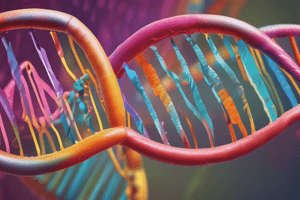Podcast
Questions and Answers
What is the frequency of alleles referred to as polymorphisms?
What is the frequency of alleles referred to as polymorphisms?
- Less than 0.1%
- Less than 5%
- Greater than 1% (correct)
- Exactly 0.5%
What is the term for different versions of a locus?
What is the term for different versions of a locus?
- Haplotypes
- Variants
- Alleles (correct)
- Genotypes
Why do nearby alleles tend to be inherited together?
Why do nearby alleles tend to be inherited together?
- Because they are on the same chromosome
- Because they are on the same chromosome arm
- Because they are linked by meiotic recombination
- Because chromosomes are very large and crossovers are rare (correct)
What is the term for a group of alleles inherited from a single parent on the same chromosome homologue?
What is the term for a group of alleles inherited from a single parent on the same chromosome homologue?
What is the frequency of SNVs (Single Nucleotide Variants) in the human genome?
What is the frequency of SNVs (Single Nucleotide Variants) in the human genome?
What is the main reason why SNVs are often analyzed in genetic studies?
What is the main reason why SNVs are often analyzed in genetic studies?
What type of genetic variant was widely used in genetic studies before 2010?
What type of genetic variant was widely used in genetic studies before 2010?
In which field is the short tandem repeat type of genetic variant still used today?
In which field is the short tandem repeat type of genetic variant still used today?
What phenomenon allows a harmful allele to increase in frequency in a population?
What phenomenon allows a harmful allele to increase in frequency in a population?
Why does the sickle cell anaemia allele HbS increase in frequency in certain areas of Africa?
Why does the sickle cell anaemia allele HbS increase in frequency in certain areas of Africa?
What is the distribution pattern of sequence variation across the human genome?
What is the distribution pattern of sequence variation across the human genome?
Which type of trait involves many genes and can also be influenced by environmental factors?
Which type of trait involves many genes and can also be influenced by environmental factors?
Which of the following diseases is an example of a single gene disorder?
Which of the following diseases is an example of a single gene disorder?
How do variants in exons typically compare to those in non-coding regions in terms of potential impact?
How do variants in exons typically compare to those in non-coding regions in terms of potential impact?
What is the outcome of random mating according to the Hardy-Weinberg Law?
What is the outcome of random mating according to the Hardy-Weinberg Law?
Which of the following is necessary for a population to be in Hardy-Weinberg Equilibrium?
Which of the following is necessary for a population to be in Hardy-Weinberg Equilibrium?
What is the frequency of heterozygous genotype (Aa) for a biallelic gene in a population?
What is the frequency of heterozygous genotype (Aa) for a biallelic gene in a population?
Why might the Hardy-Weinberg Law be disrupted in certain populations?
Why might the Hardy-Weinberg Law be disrupted in certain populations?
Which factor can cause a population bottleneck, affecting genetic variation?
Which factor can cause a population bottleneck, affecting genetic variation?
What does the Hardy-Weinberg equation predict for allele frequencies in a stable population over generations?
What does the Hardy-Weinberg equation predict for allele frequencies in a stable population over generations?
Which scenario could lead to genetic drift in a population?
Which scenario could lead to genetic drift in a population?
What does purifying (negative) selection do to allele frequencies?
What does purifying (negative) selection do to allele frequencies?
When a population experiences a founder effect, what typically happens?
When a population experiences a founder effect, what typically happens?
How can allele frequencies be deduced within a population in Hardy-Weinberg Equilibrium?
How can allele frequencies be deduced within a population in Hardy-Weinberg Equilibrium?
What is the primary focus of WGS and WES in disease research?
What is the primary focus of WGS and WES in disease research?
What is the purpose of large projects like UK Biobank?
What is the purpose of large projects like UK Biobank?
How are the causal variants/alleles characterized in monogenic disorders?
How are the causal variants/alleles characterized in monogenic disorders?
What is the challenge in identifying predisposing variants in common complex disease?
What is the challenge in identifying predisposing variants in common complex disease?
What is the Online Mendelian Inheritance in Man (OMIM) database?
What is the Online Mendelian Inheritance in Man (OMIM) database?
What type of disease is often studied using family-based linkage studies?
What type of disease is often studied using family-based linkage studies?
What is a characteristic of common complex disease?
What is a characteristic of common complex disease?
What is a consideration in large-scale genetic studies?
What is a consideration in large-scale genetic studies?
What is the main purpose of genetic linkage studies?
What is the main purpose of genetic linkage studies?
In the provided example, what indicates the presence of a causal mutation?
In the provided example, what indicates the presence of a causal mutation?
What do the unshaded bars represent in the pedigree example?
What do the unshaded bars represent in the pedigree example?
What process causes recombination events that break up chromosome segments?
What process causes recombination events that break up chromosome segments?
How do polymorphic loci act in genetic linkage studies?
How do polymorphic loci act in genetic linkage studies?
Why is sequencing required even after identifying a chromosomal region linked to a trait?
Why is sequencing required even after identifying a chromosomal region linked to a trait?
What does the term 'haplotype' refer to in the context of the example?
What does the term 'haplotype' refer to in the context of the example?
What challenge is often faced when a chromosomal region linked to a trait is identified?
What challenge is often faced when a chromosomal region linked to a trait is identified?
What is one of the reasons whole genome sequencing remains challenging?
What is one of the reasons whole genome sequencing remains challenging?
Why have genetic linkage studies been more successful in identifying genes for monogenic disorders compared to common complex diseases?
Why have genetic linkage studies been more successful in identifying genes for monogenic disorders compared to common complex diseases?
What type of genetic study is exemplified by the Deciphering Developmental Disorders (DDD) Study?
What type of genetic study is exemplified by the Deciphering Developmental Disorders (DDD) Study?
In the context of genetic studies, what does the term 'concordance rate' refer to?
In the context of genetic studies, what does the term 'concordance rate' refer to?
Why is it difficult to identify genes underlying common complex diseases?
Why is it difficult to identify genes underlying common complex diseases?
According to twin studies, which of the following diseases shows a stronger genetic contribution?
According to twin studies, which of the following diseases shows a stronger genetic contribution?
What is a major advantage of whole exome sequencing (WES) over whole genome sequencing (WGS)?
What is a major advantage of whole exome sequencing (WES) over whole genome sequencing (WGS)?
In genetic studies, what does the term 'penetrance' refer to?
In genetic studies, what does the term 'penetrance' refer to?
What challenge is associated with the phenotypes of common complex diseases?
What challenge is associated with the phenotypes of common complex diseases?
What information can comparisons between identical (monozygotic) and non-identical (dizygotic) twins provide?
What information can comparisons between identical (monozygotic) and non-identical (dizygotic) twins provide?
What is the primary purpose of a genome-wide association study (GWAS)?
What is the primary purpose of a genome-wide association study (GWAS)?
What type of genetic variation is commonly assayed in GWAS?
What type of genetic variation is commonly assayed in GWAS?
Why is a large number of individuals required in GWAS studies?
Why is a large number of individuals required in GWAS studies?
What does a Manhattan plot show in the context of GWAS?
What does a Manhattan plot show in the context of GWAS?
Which technology is used to genotype an individual's genomic DNA for thousands of SNP loci simultaneously?
Which technology is used to genotype an individual's genomic DNA for thousands of SNP loci simultaneously?
What is one of the main reasons why many SNPs are biallelic?
What is one of the main reasons why many SNPs are biallelic?
What makes identifying the causal variant in a GWAS challenging?
What makes identifying the causal variant in a GWAS challenging?
Why is Whole Genome Sequencing (WGS) not yet common for very large scale GWAS studies?
Why is Whole Genome Sequencing (WGS) not yet common for very large scale GWAS studies?
Which diseases have been studied using GWAS to uncover contributing genes?
Which diseases have been studied using GWAS to uncover contributing genes?
Which statement is true regarding the resolution and cost trade-off in genome analysis technologies?
Which statement is true regarding the resolution and cost trade-off in genome analysis technologies?
Flashcards are hidden until you start studying
Study Notes
Genetic Variation
- Individual genomes differ at a small fraction of bases, but due to the large size of genomes, there are millions of differences between individuals.
- Each individual carries both rare and common variants.
- Alleles are different versions of a locus, and variants that arise within the germline can be inherited.
- Rare variants may be unique to an individual or shared with relatives in a family, and often have arisen in recent generations.
- Common variants are shared with many others in a population, often having no/little effect on phenotype, and arose many generations ago, spreading through the population.
Types of Genetic Variation
- Single Nucleotide Variants (SNVs) or Single Nucleotide Polymorphisms (SNPs) are the most commonly analyzed type of genetic variation.
- SNPs occur frequently (~1 every 1kb in the human genome) and are easy to assay.
- Other types of genetic variation include short tandem repeats (also known as microsatellites), which are still used in forensics for DNA fingerprinting.
Hardy-Weinberg Law and Allele Frequencies
- The Hardy-Weinberg Law is a mathematical relationship between allele and genotype frequencies in an idealized population.
- Random mating results in genotype frequencies that are a simple function of allele frequencies.
- The law states that p² + 2pq + q² = 1, where p and q are the frequencies of two alleles in a biallelic gene.
- Allele frequencies can be deduced from genotype frequencies in the same generation.
- Genotype frequencies can be computed from allele frequencies if the population is in Hardy-Weinberg Equilibrium (HWE).
Applications of Hardy-Weinberg Law
- The HW equation is often used in clinical situations to calculate the frequency of carriers of autosomal recessive disorders.
- However, Hardy-Weinberg equilibrium can be disrupted by non-random mating, population bottlenecks, founder effects, and genetic drift.
Genetic Variation and Disease
- Single gene disorders are individually rare, but have a strong genetic component, and are often caused by mutations in a single gene.
- Complex traits involve many genes and environmental factors, and are more common.
- Variants occurring within exons are more likely to affect the function of a gene product and be real mutations.
- Variants outside exons are more likely to be neutral variants.
Genetic Linkage Studies
- Genetic linkage studies follow the inheritance of a trait in an affected family (pedigree) and look for co-segregation of the phenotype with alleles of polymorphic genetic loci from across the genome.
- The approach identifies a chromosomal segment that appears to be present in those with the trait.
- The alleles at polymorphic loci act as tags allowing the inheritance of chromosomal segments to be tracked through the pedigree.
- This approach points to a segment of the genome where the gene underlying the phenotype is likely to be.
Limitations of Genetic Linkage Studies
- The chromosomal region identified by genetic linkage studies is often quite large (many Mbps) and may encompass many genes.
- Sequencing is required to identify the causal mutation and gene responsible.
Historical Importance of Genetic Linkage Studies
- Genetic linkage studies have been a powerful way of identifying genes underlying disorders caused by a genotype at a single locus that has high penetrance and a predictable inheritance pattern in families (Mendelian inheritance).
Challenges of Identifying Genes Underlying Common Complex Traits
- Common complex diseases have a major impact on health and form the bulk of the disease burden in industrialized societies.
- Identifying genes underlying common complex diseases is challenging because many genes contribute to individual predisposition to the phenotype, with most genetic variants contributing in only a small way.
- The phenotype is often hard to classify, with many subtypes and no straightforward pattern of inheritance is seen.
- Environmental factors also influence the trait.
Twin Studies
- Twin studies are used to quantify the extent of genetic and environmental contributions to a trait.
- The concordance rate for monozygotic twins is higher than for dizygotic twins.
- The higher the concordance rate, the more important the genetic contribution.
Genome-Wide Association Studies (GWAS)
- GWAS is an alternative to family/pedigree-based linkage studies.
- The approach looks for genetic variants shared by “unrelated” people with a trait/disease.
- The logic behind this approach is that many genetic variants can each increase susceptibility to a particular trait to a small extent.
- These variants are themselves quite benign and can persist and spread in the population, over many generations.
- The type of genetic variation assayed in such studies is the SNP (Single Nucleotide Polymorphism).
GWAS Data Analysis
- GWAS data is presented in the form of “Manhattan plots”, where the x-axis shows the chromosomal location of each SNP, and the y-axis shows the statistical significance of the association of each SNP with the particular trait.
- The green peaks in the plots represent SNPs that show significance values above the threshold.
Limitations of GWAS
- Once associated SNPs have been identified by GWAS, the causal variant then needs to be pinpointed, which can be challenging.
- Many SNPs lie outside protein-coding genes, in regions of the genome with no known function.
Whole Genome Sequencing (WGS) and Whole Exome Sequencing (WES)
- WGS and WES are approaches that allow all the genetic variation in a genome to be assayed – the highest resolution possible.
- However, because of the expense, this approach is not yet common for very large scale studies.
- There is a trade-off between cost and the amount of genetic variation you can sample.
Large-Scale Projects
- Large-scale projects, such as the UK Biobank, hold great promise for identifying the underlying genetic basis of common complex disease.
- These projects are resource-intensive but are long-term investments that are generating growing datasets.
- Issues of secure data storage, anonymity of data generated, and the ethics of sampling are carefully considered.
Online Mendelian Inheritance in Man (OMIM) Database
- OMIM is a comprehensive compendium of human genes and genetic phenotypes, updated daily.
- OMIM contains information on all known monogenic disorders, on over 15,000 genes, and a rapidly growing number of genes associated with susceptibility to common complex disease.
Studying That Suits You
Use AI to generate personalized quizzes and flashcards to suit your learning preferences.




